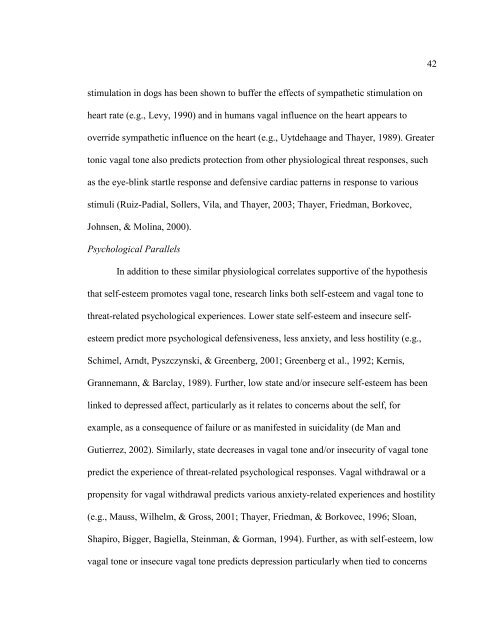1 THE AUTONOMIC PHYSIOLOGY OF TERROR MANAGEMENT ...
1 THE AUTONOMIC PHYSIOLOGY OF TERROR MANAGEMENT ...
1 THE AUTONOMIC PHYSIOLOGY OF TERROR MANAGEMENT ...
You also want an ePaper? Increase the reach of your titles
YUMPU automatically turns print PDFs into web optimized ePapers that Google loves.
stimulation in dogs has been shown to buffer the effects of sympathetic stimulation on<br />
heart rate (e.g., Levy, 1990) and in humans vagal influence on the heart appears to<br />
override sympathetic influence on the heart (e.g., Uytdehaage and Thayer, 1989). Greater<br />
tonic vagal tone also predicts protection from other physiological threat responses, such<br />
as the eye-blink startle response and defensive cardiac patterns in response to various<br />
stimuli (Ruiz-Padial, Sollers, Vila, and Thayer, 2003; Thayer, Friedman, Borkovec,<br />
Johnsen, & Molina, 2000).<br />
Psychological Parallels<br />
In addition to these similar physiological correlates supportive of the hypothesis<br />
that self-esteem promotes vagal tone, research links both self-esteem and vagal tone to<br />
threat-related psychological experiences. Lower state self-esteem and insecure self-<br />
esteem predict more psychological defensiveness, less anxiety, and less hostility (e.g.,<br />
Schimel, Arndt, Pyszczynski, & Greenberg, 2001; Greenberg et al., 1992; Kernis,<br />
Grannemann, & Barclay, 1989). Further, low state and/or insecure self-esteem has been<br />
linked to depressed affect, particularly as it relates to concerns about the self, for<br />
example, as a consequence of failure or as manifested in suicidality (de Man and<br />
Gutierrez, 2002). Similarly, state decreases in vagal tone and/or insecurity of vagal tone<br />
predict the experience of threat-related psychological responses. Vagal withdrawal or a<br />
propensity for vagal withdrawal predicts various anxiety-related experiences and hostility<br />
(e.g., Mauss, Wilhelm, & Gross, 2001; Thayer, Friedman, & Borkovec, 1996; Sloan,<br />
Shapiro, Bigger, Bagiella, Steinman, & Gorman, 1994). Further, as with self-esteem, low<br />
vagal tone or insecure vagal tone predicts depression particularly when tied to concerns<br />
42

















